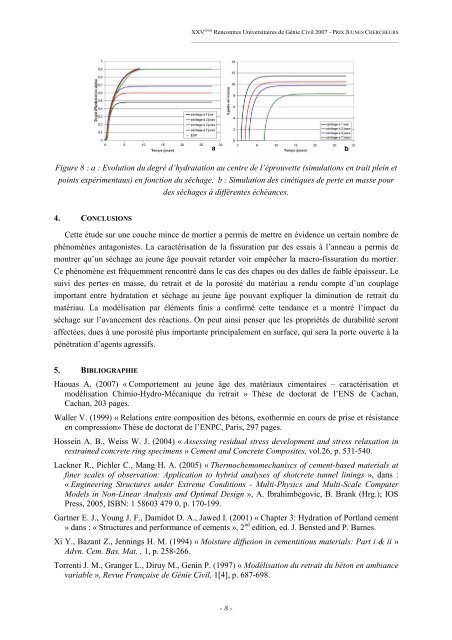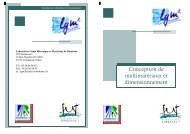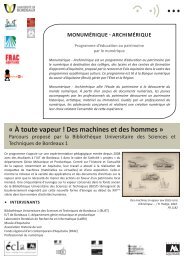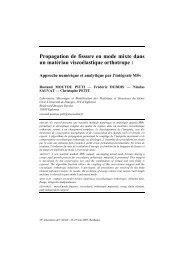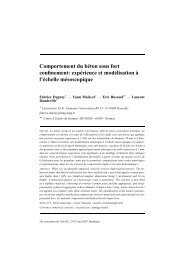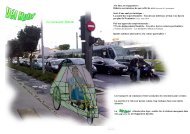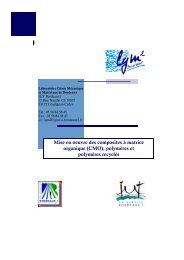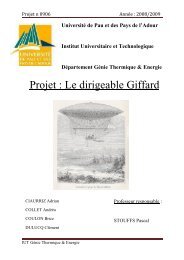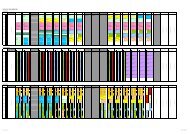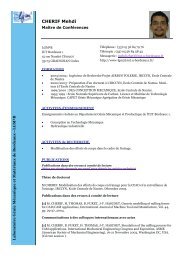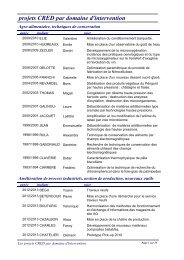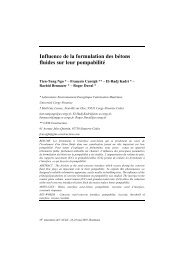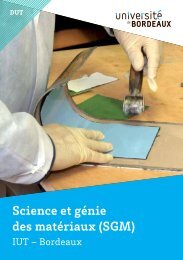Caractérisation et modélisation de l'effet du ... - IUT Bordeaux 1...
Caractérisation et modélisation de l'effet du ... - IUT Bordeaux 1...
Caractérisation et modélisation de l'effet du ... - IUT Bordeaux 1...
You also want an ePaper? Increase the reach of your titles
YUMPU automatically turns print PDFs into web optimized ePapers that Google loves.
XXV emes Rencontres Universitaires <strong>de</strong> Génie Civil 2007 - PRIX JEUNES CHERCHEURS<br />
_____________________________________________________________________________________________________________<br />
Figure 8 : a : Evolution <strong>du</strong> <strong>de</strong>gré d’hydratation au centre <strong>de</strong> l’éprouv<strong>et</strong>te (simulations en trait plein <strong>et</strong><br />
points expérimentaux) en fonction <strong>du</strong> séchage, b : Simulation <strong>de</strong>s cinétiques <strong>de</strong> perte en masse pour<br />
<strong>de</strong>s séchages à différentes échéances.<br />
4. CONCLUSIONS<br />
C<strong>et</strong>te étu<strong>de</strong> sur une couche mince <strong>de</strong> mortier a permis <strong>de</strong> m<strong>et</strong>tre en évi<strong>de</strong>nce un certain nombre <strong>de</strong><br />
phénomènes antagonistes. La caractérisation <strong>de</strong> la fissuration par <strong>de</strong>s essais à l’anneau a permis <strong>de</strong><br />
montrer qu’un séchage au jeune âge pouvait r<strong>et</strong>ar<strong>de</strong>r voir empêcher la macro-fissuration <strong>du</strong> mortier.<br />
Ce phénomène est fréquemment rencontré dans le cas <strong>de</strong>s chapes ou <strong>de</strong>s dalles <strong>de</strong> faible épaisseur. Le<br />
suivi <strong>de</strong>s pertes en masse, <strong>du</strong> r<strong>et</strong>rait <strong>et</strong> <strong>de</strong> la porosité <strong>du</strong> matériau a ren<strong>du</strong> compte d’un couplage<br />
important entre hydratation <strong>et</strong> séchage au jeune âge pouvant expliquer la diminution <strong>de</strong> r<strong>et</strong>rait <strong>du</strong><br />
matériau. La <strong>modélisation</strong> par éléments finis a confirmé c<strong>et</strong>te tendance <strong>et</strong> a montré l’impact <strong>du</strong><br />
séchage sur l’avancement <strong>de</strong>s réactions. On peut ainsi penser que les propriétés <strong>de</strong> <strong>du</strong>rabilité seront<br />
affectées, <strong>du</strong>es à une porosité plus importante principalement en surface, qui sera la porte ouverte à la<br />
pénétration d’agents agressifs.<br />
5. BIBLIOGRAPHIE<br />
Haouas A. (2007) « Comportement au jeune âge <strong>de</strong>s matériaux cimentaires – caractérisation <strong>et</strong><br />
<strong>modélisation</strong> Chimio-Hydro-Mécanique <strong>du</strong> r<strong>et</strong>rait » Thèse <strong>de</strong> doctorat <strong>de</strong> l’ENS <strong>de</strong> Cachan,<br />
Cachan, 203 pages.<br />
Waller V. (1999) « Relations entre composition <strong>de</strong>s bétons, exothermie en cours <strong>de</strong> prise <strong>et</strong> résistance<br />
en compression» Thèse <strong>de</strong> doctorat <strong>de</strong> l’ENPC, Paris, 297 pages.<br />
Hossein A. B., Weiss W. J. (2004) « Assessing resi<strong>du</strong>al stress <strong>de</strong>velopment and stress relaxation in<br />
restrained concr<strong>et</strong>e ring specimens » Cement and Concr<strong>et</strong>e Composites, vol.26, p. 531-540.<br />
Lackner R., Pichler C., Mang H. A. (2005) « Thermochemomechaniscs of cement-based materials at<br />
finer scales of observation: Application to hybrid analyses of shotcr<strong>et</strong>e tunnel linings », dans :<br />
« Engineering Structures un<strong>de</strong>r Extreme Conditions - Multi-Physics and Multi-Scale Computer<br />
Mo<strong>de</strong>ls in Non-Linear Analysis and Optimal Design », A. Ibrahimbegovic, B. Brank (Hrg.); IOS<br />
Press, 2005, ISBN: 1 58603 479 0, p. 170-199.<br />
Gartner E. J., Young J. F., Damidot D. A., Jawed I. (2001) « Chapter 3: Hydration of Portland cement<br />
» dans : « Structures and performance of cements », 2 nd edition, ed. J. Bensted and P. Barnes.<br />
Xi Y., Bazant Z., Jennings H. M. (1994) « Moisture diffusion in cementitious materials: Part i & ii »<br />
Advn. Cem. Bas. Mat. , 1, p. 258-266.<br />
Torrenti J. M., Granger L., Diruy M., Genin P. (1997) « Modélisation <strong>du</strong> r<strong>et</strong>rait <strong>du</strong> béton en ambiance<br />
variable », Revue Française <strong>de</strong> Génie Civil, 1[4], p. 687-698.<br />
- 8 -


